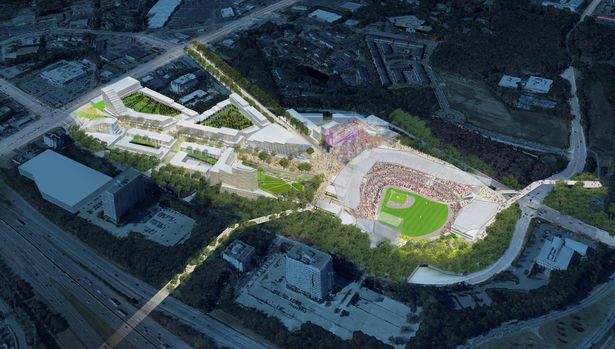
This is, in many ways, the fun part: with the decision made to build a new ballpark, members of the Atlanta Braves front office have been touring other MLB ballparks in search of inspiration.
There’s probably little the Braves can take away from Turner Field in terms of inspiration: with narrow concourses, a generic feel and a lack of integration into the surrounding area, Turner Field is certainly as bland as it gets. So the Braves officials have visited several MLB ballparks — Target Field, Busch Stadium and Ballpark Village, Kauffman Stadium — and have more trips to the West Coast planned. From the Atlanta Journal-Constitution (paid firewall):
In each stadium we go to, there are nuggets we find,” said [Derek] Schiller, the Braves’ executive vice president of sales and marketing, who made notes on his iPad as he toured Busch Stadium.
For their new stadium — slated to open in 2017 at a cost of up to $672 million, including $300 million in Cobb County taxpayer money — the Braves say they’ll borrow elements from many venues but replicate none.
“We want to do something different,” [Mike] Plant, the Braves’ executive vice president of business operations and the point person on the stadium project, said as he stood on the snow in front of the Cardinals’ dugout and peered across expanses of red seats.
The Braves will face some special challenges as they design a new ballpark and entertainment district/commercial development. First, there’s the issue of context. Almost every new ballpark since Oriole Park at Camden Yards has some built-in context, whether it be the downtown Minneapolis skyline and brick warehouses next to Target Field, the bay view from AT&T Park or the scenic skyline of St. Louis framing the outfield views from Busch Stadium. Conversely, some of the less successful MLB ballparks lack such a context, such as Marlins Park.
Now, the Braves have some disadvantages and advantages in building out in Cobb County. The whole area is a blank canvas, giving architects a chance to make a major statement with both the ballpark and the surrounding area. But Cobb County is pretty much suburbia at its best and worse: it sprawls, much of it was constructed on the cheap, and there no context to reflect. The best ballparks work when they feel like they’ve been there forever: Target Field is so tightly intertwined with the neighborhood that it feels like it’s been in downtown Minneapolis since 1950 or so. We’ll be interested to see what the Braves front office takes away from their ballpark tour and how they apply it to suburban Atlanta.
RELATED STORIES: Braves may ask for state aid on new ballpark; Ted Turner: Preserve Turner Field as green space; New Braves ballpark hits resistance from school district, Tea Party; Could new Braves ballpark be derailed by lawsuit?; New Braves ballpark hits $1B with additional of entertainment district; Gone too soon, or good riddance? Thoughts in Turner Field’s future demolition; Braves to pay $372M toward new ballpark, Cobb County $300M; Turner Field to be torn down in 2017; Braves to leave Turner Field, will build new Cobb County ballpark
—-
Share your news with the baseball community. Send it to us at editors@augustpublications.com.
Are you a subscriber to the weekly Ballpark Digest newsletter? You can sign up for a free subscription at the Newsletter Signup Page.
Join Ballpark Digest on Facebook and on Twitter!
Follow Ballpark Digest on Google + and add us to your circles!
